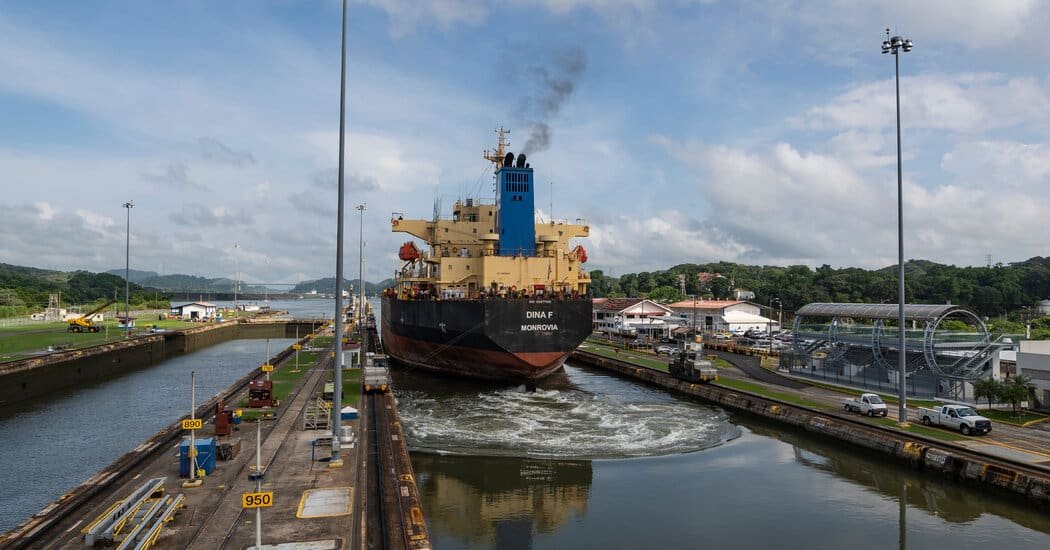[ad_1]
The current dry spell in the Panama Canal was driven not by international warming however by below-normal rains connected to the all-natural environment cycle El Niño, a global group of researchers has actually ended.
Reduced tank degrees have actually reduced freight website traffic in the canal for a lot of the previous year. Without sufficient water to elevate and reduced ships, authorities last summer season needed to lower the variety of vessels they permitted via, developing pricey frustrations for delivery business worldwide. Just in current months have crossings began to get once again.
The location’s water fears might still strengthen in the coming years, the scientists stated in their analysis of the drought. As Panama’s populace expands and seaborne profession expands, water need is anticipated to be a much bigger share of readily available supply by 2050, according to the government. That implies future El Niño years might bring also larger disturbances, not simply to international delivery, however likewise to water materials for regional homeowners.
” Also tiny modifications in rainfall can bring out of proportion effects,” stated Maja Vahlberg, a danger expert for the Red Cross Red Crescent Environment Facility that added to the brand-new evaluation, which was released on Wednesday.
Panama, generally, is just one of the wettest position on Planet. Generally, the location around the canal obtains greater than 8 feet of rainfall a year, mostly all of it in the May-to-December damp period. That rainfall is crucial both for canal procedures and for the alcohol consumption water eaten by around half of the nation’s 4.5 million individuals.
In 2014, however, rains was available in at concerning a quarter listed below typical, making it the country’s third-driest year in virtually a century and a fifty percent of documents. The drought took place not long after 2 others that likewise interfered with canal website traffic: one in 1997-98, the various other in 2015-16. All 3 accompanied El Niño problems.
” We have actually never ever had a group of numerous truly extreme occasions in such a brief time,” stated Steven Paton, supervisor of the Smithsonian Tropical Study Institute’s Physical Surveillance Program in Panama. He and the various other researchers that carried out the brand-new evaluation wished to know: Was this simply rotten luck? Or was it pertaining to international warming and for that reason a precursor of points to find?
To respond to the inquiry, the scientists looked both at climate documents in Panama and at computer system designs that mimic the international environment under various problems.
The researchers discovered that little rainfall, low temperature levels that create even more water to vaporize, was the major factor for low tide in the canal’s storage tanks. The climate documents recommend that wet-season rains in Panama has actually reduced decently in current years. Yet the designs do not show that human-induced environment adjustment is the chauffeur.
” We’re unsure what is creating that mild drying out pattern, or whether it’s an abnormality, or a few other element that we have not thought about,” stated Clair Barnes, an environment scientist at Imperial University London that worked with the evaluation. “Future patterns in a warming environment are likewise unclear.”
El Niño, by comparison, is far more plainly related to below-average rains in the location, the researchers discovered. In any kind of provided El Niño year, there’s a 5 percent opportunity that rains there will certainly be as reduced as it remained in 2023, they approximated.
Right now, El Niño problems are compromising, according to the National Oceanic and Atmospheric Management. La Niña, the contrary stage of the cycle, is anticipated to appear this summer season.
The researchers that evaluated the Panama Canal dry spell are associated with Globe Weather condition Acknowledgment, a research study campaign that checks out severe climate occasions right after they happen. Their searchings for concerning the dry spell have not yet been peer evaluated.
[ad_2]
Source link .




